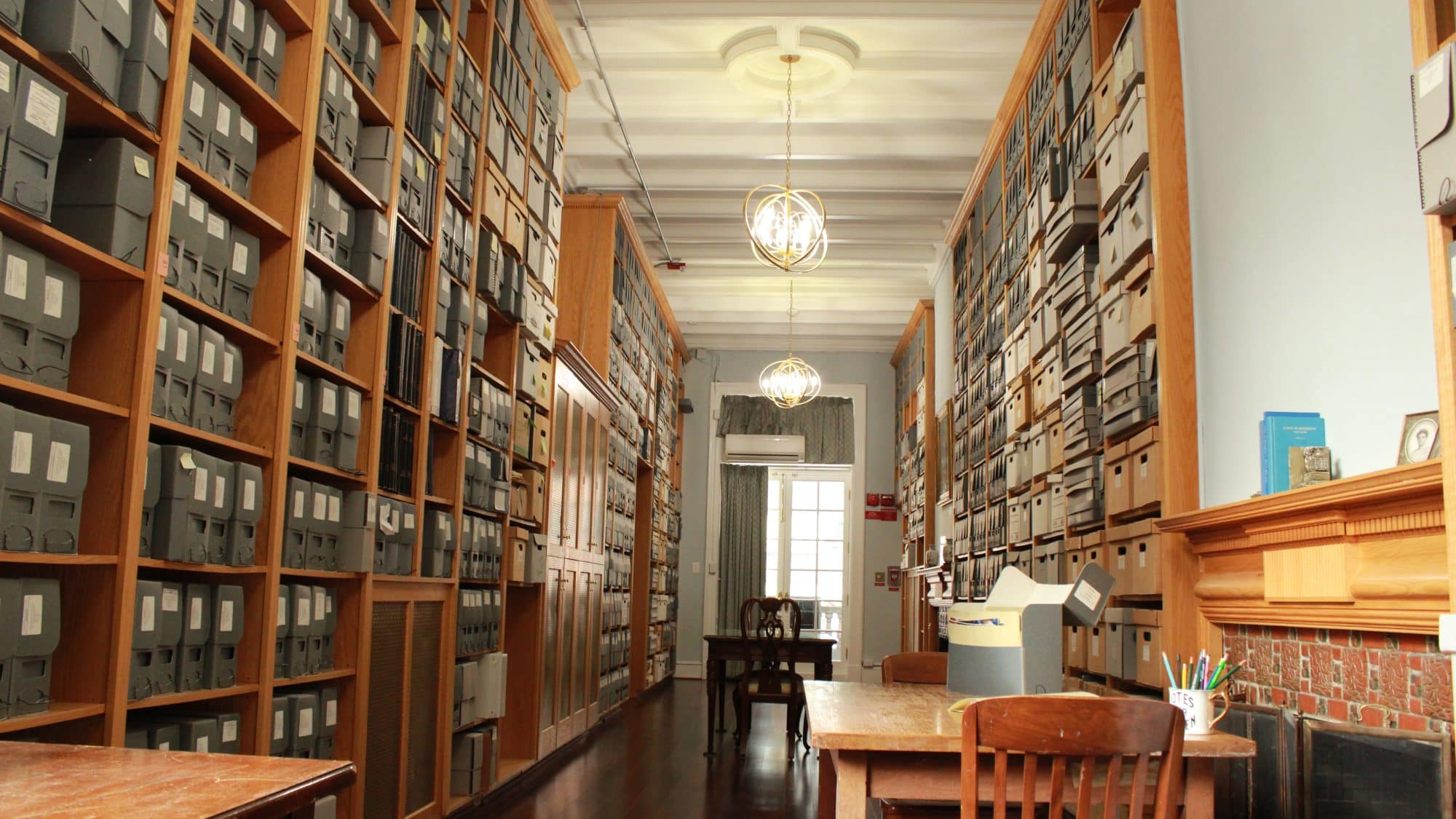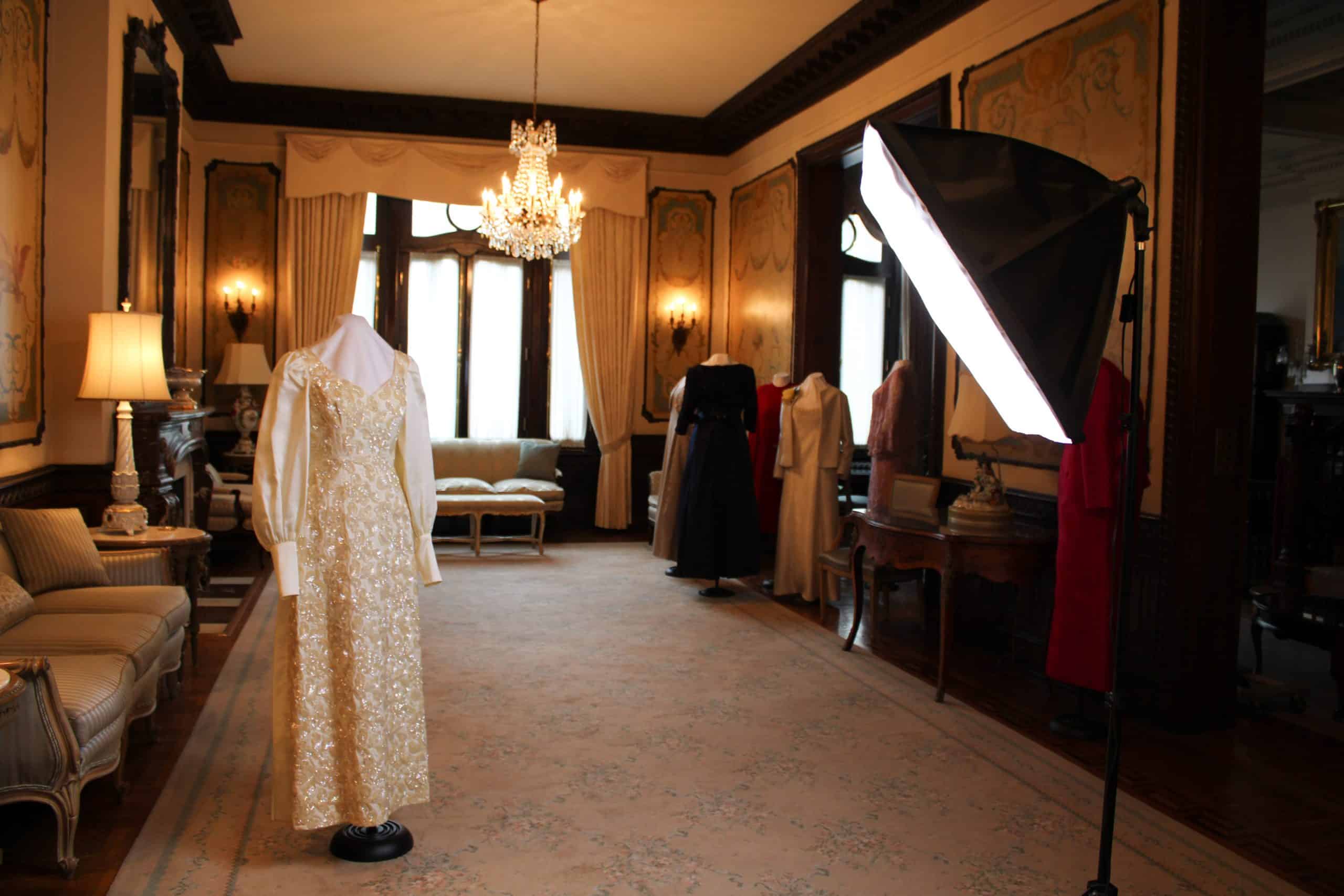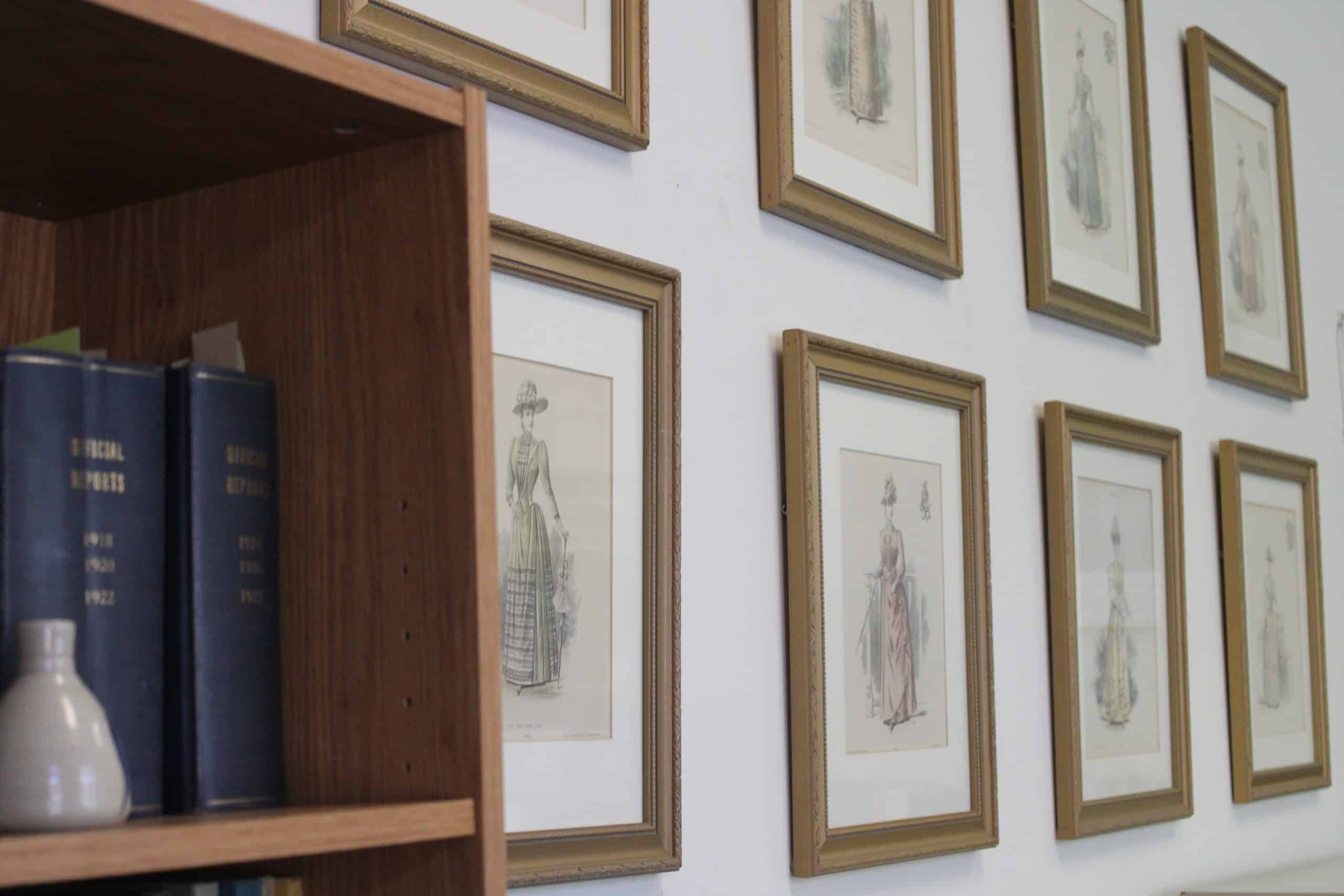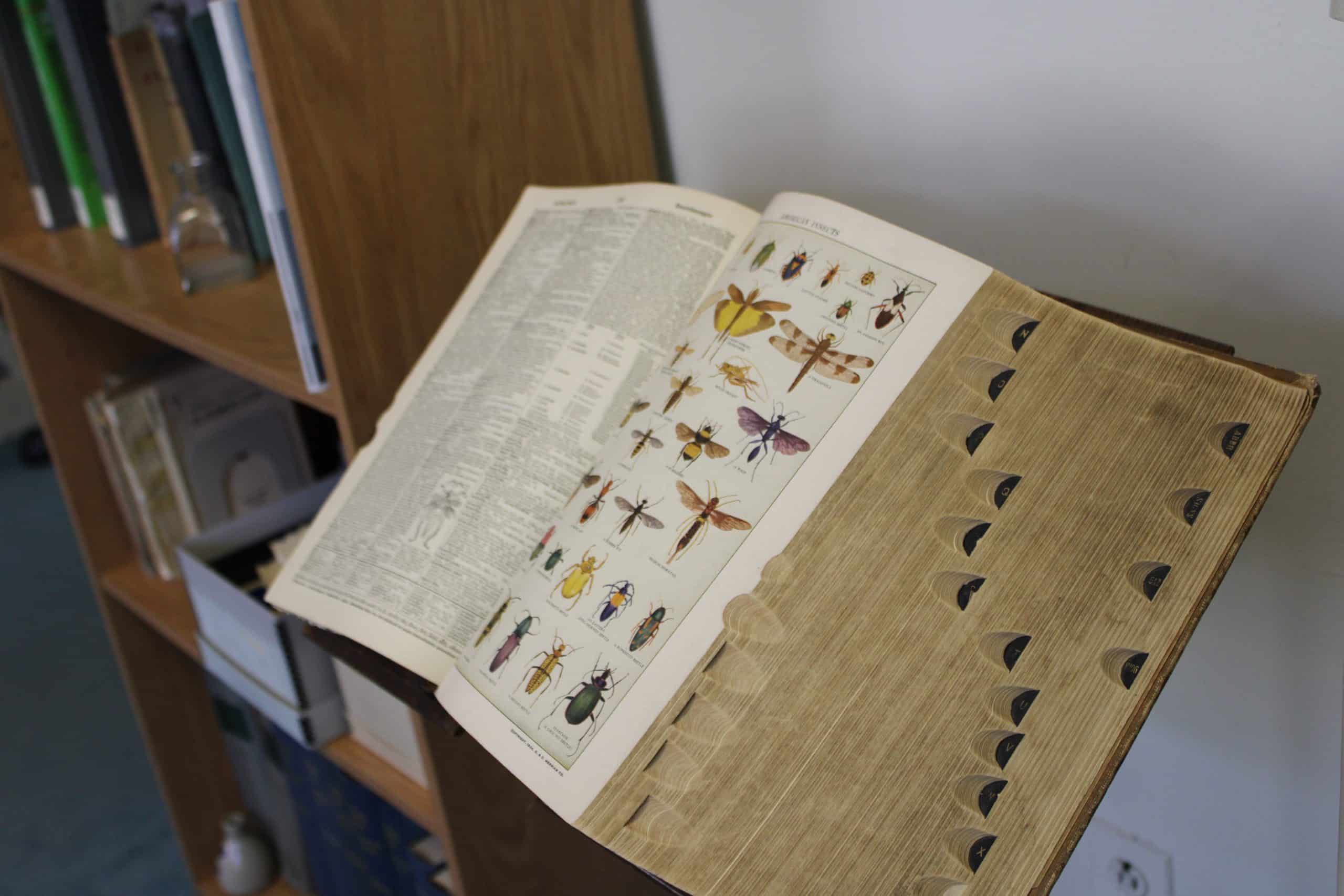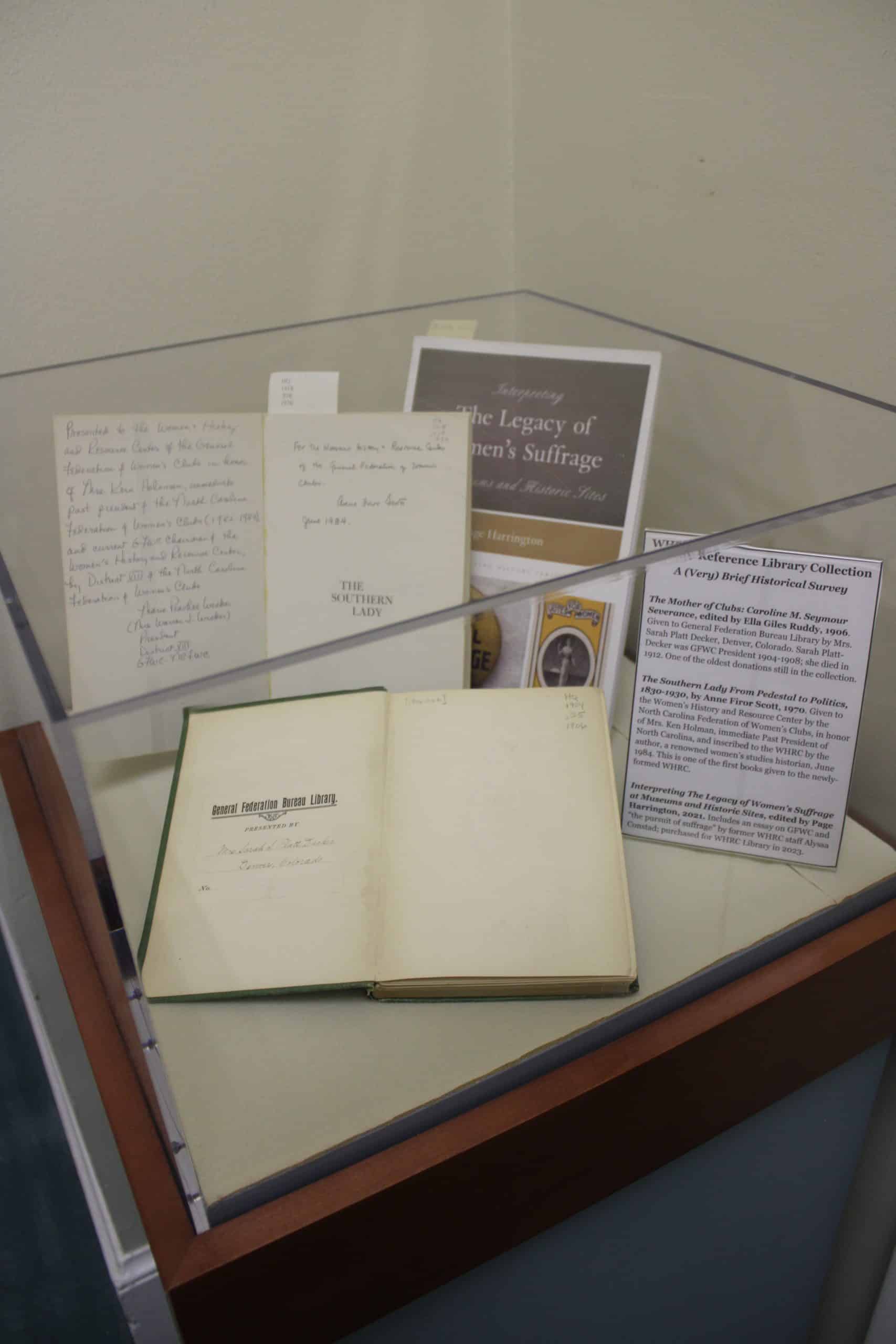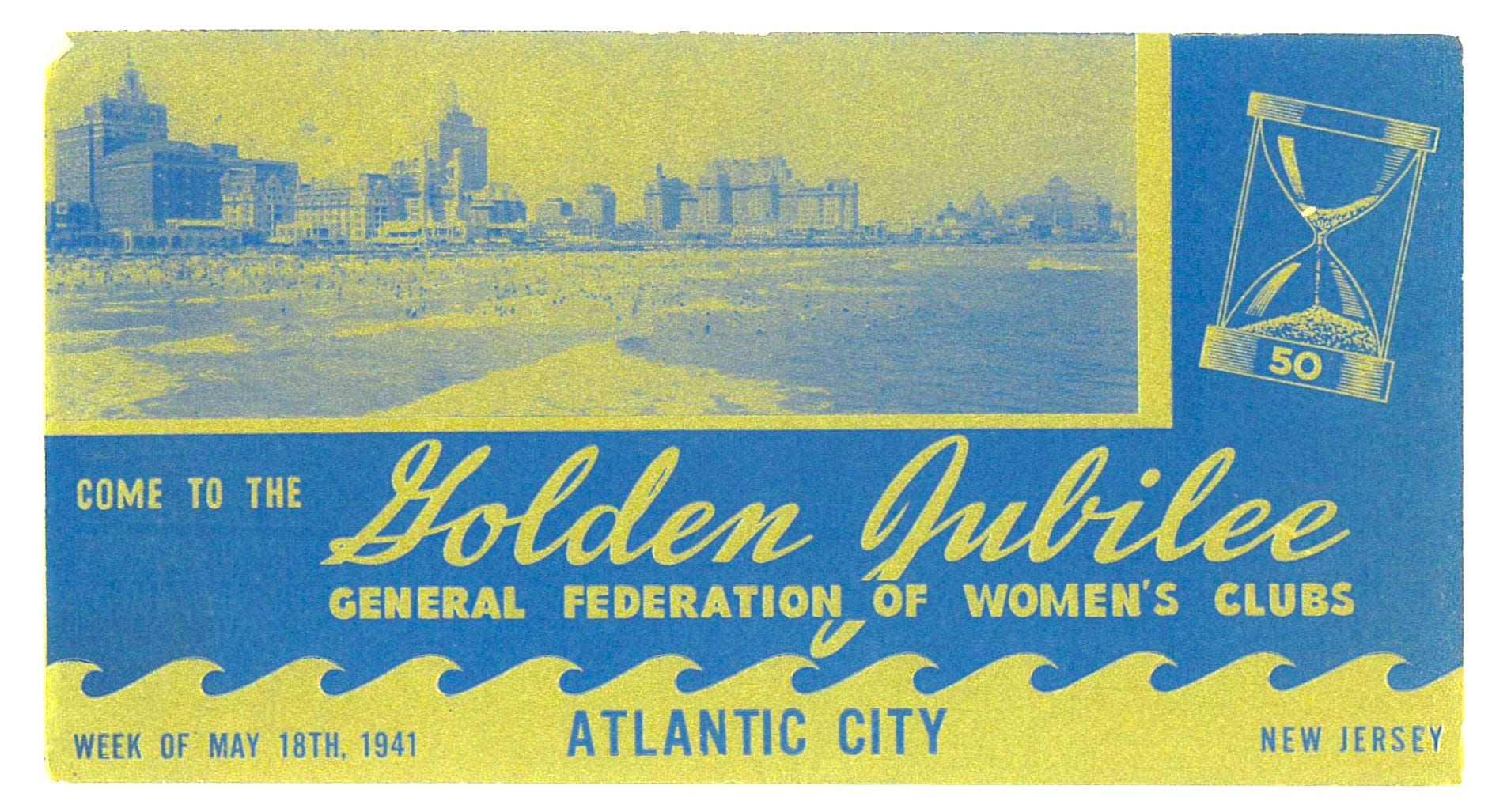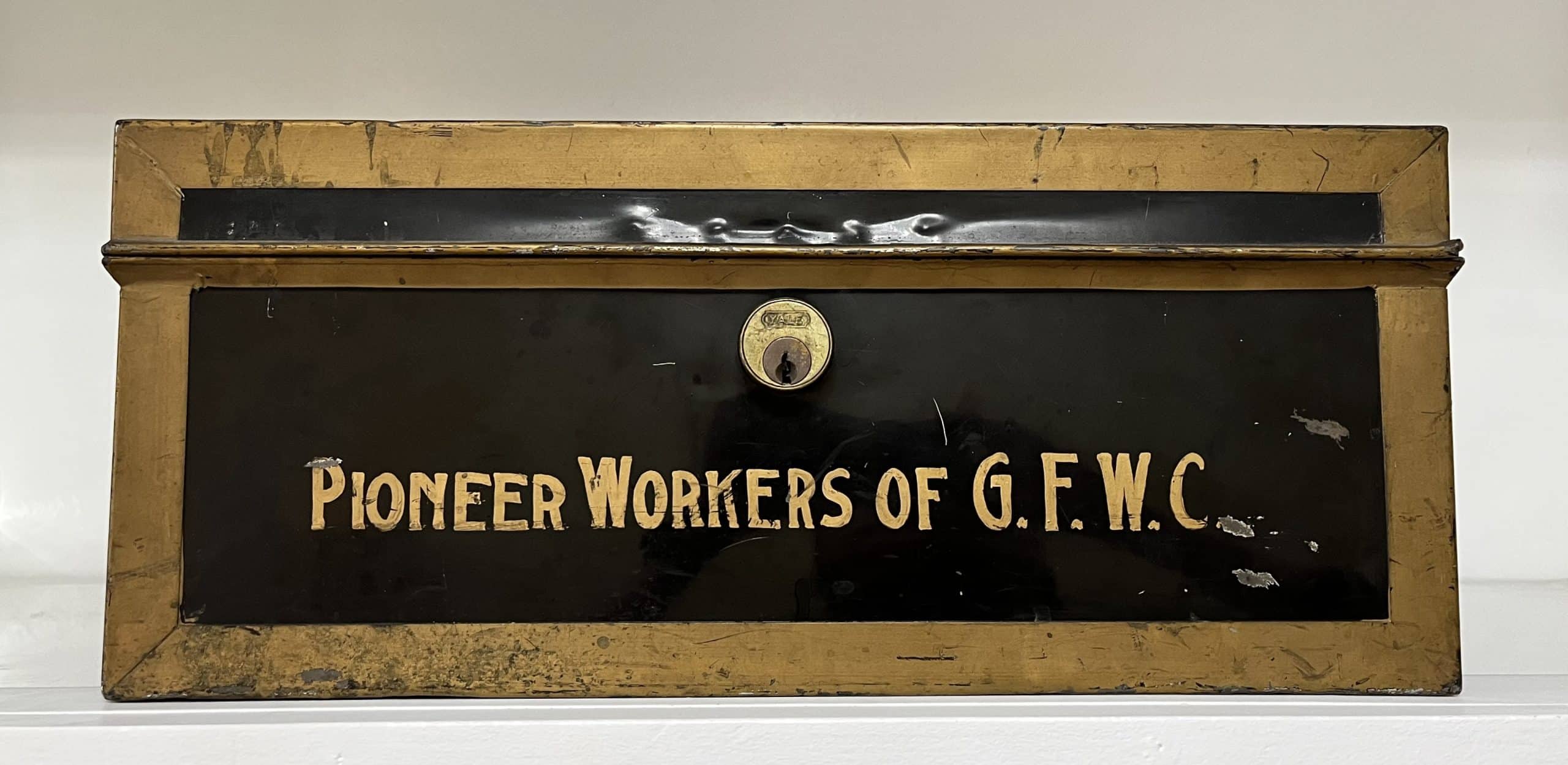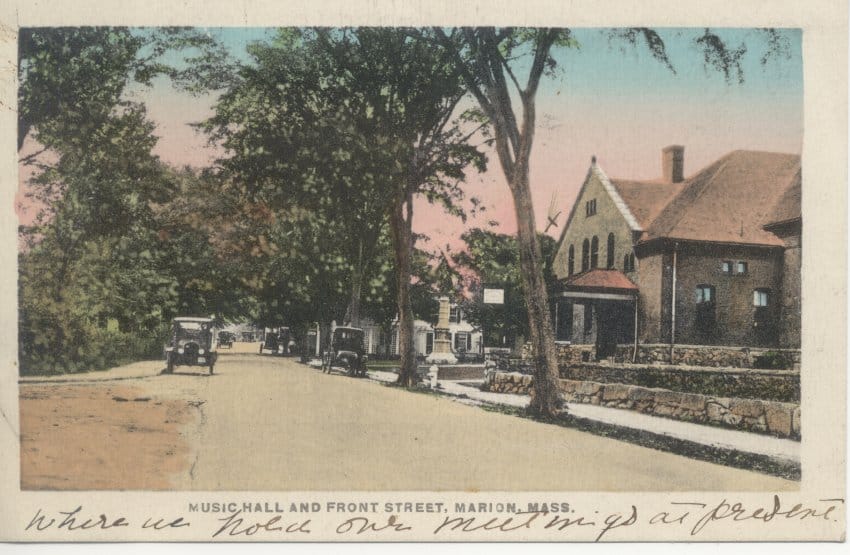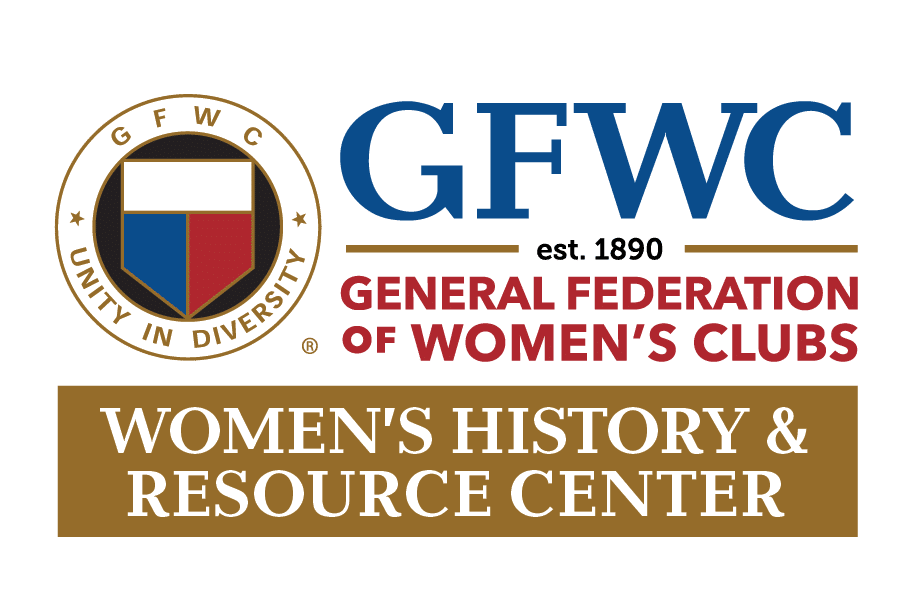
Founded in 1984, the GFWC Women’s History and Resource Center (WHRC) collects, preserves, interprets, and promotes the history of GFWC. The WHRC documents the social and political contributions of GFWC clubwomen from 1890 to the present through the GFWC archives and related special collections. Our holdings are available for research by clubwomen, academics, and the general public.
The WHRC collections encompass GFWC’s institutional archives, including convention records, files related to our programs and leadership, and “Clubwoman” magazine (and its predecessors). We hold a robust photograph and audio-visual collection, as well as GFWC ephemera, memorabilia, and the art and artifacts that furnish our historic Headquarters building. We also maintain a reference library collection focused on women’s history, the woman’s club movement, and the history of volunteerism.
Please note: While we do have many state- and club-level archival and photographic materials, we do not maintain official records for State Federations or local clubs, or for outside organizations.
WHRC: From the Archives
Everybody Loves a Birthday Party The General Federation of Women’s Clubs, founded on April 24,…
WHRC: From the Archives
Pioneer Workers of the General Federation Generally speaking, the Women’s History and Resource Cente…
WHRC: From the Archives
“Where we meet at present”: The GFWC Clubhouse Photo Collection Although most of the GFW…
Research at the WHRC
Learn more about the collections, request research assistance, or make an appointment to visit in person. To inquire about a potential donation, please email us with details: whrc@gfwc.org
LEARN MOREA few weeks ago, the GFWC Women’s History and Resource Center had an info table at the DC history Convention. It was wonderful to reach lots of potential researchers – but we heard too many times, “oh, but your archives must be only for members.” Not so! All are welcome in the WHRC: club members, students, academic researchers, and the general public. (By appointment only, though, please and thank you!) Do you, or someone you know, have a history research project that might intersect with GFWC’s 135 years of work on hundreds of causes? Let us know and we’ll be glad to help! #womenshistoryisamericanhistory

A few weeks ago, the GFWC Women’s History and Resource Center had an info table at the DC history Convention. It was wonderful to reach lots of potential researchers – but we heard too many times, “oh, but your archives must be only for members.” Not so! All are welcome in the WHRC: club members, students, academic researchers, and the general public. (By appointment only, though, please and thank you!) Do you, or someone you know, have a history research project that might intersect with GFWC’s 135 years of work on hundreds of causes? Let us know and we’ll be glad to help! #womenshistoryisamericanhistory
April is #NationalPoetryMonth, a perfect opportunity to highlight the GFWC poetry collection! This volume is one of my personal favorites, thanks to its cheerful cover, springtime content, and connection to the woman who is the reason we even have a GFWC poetry collection: Anita Browne (1894-1966), who served as our Chairman of Poetry in the early 1930s. During her term she collected regional poetry for the GFWC library, and held contests for poetic clubwomen.
Browne went on to work as Director of the National Poetry Center in New York City, and donated even more volumes of poetry to our library from the Center`s Poets Press. She also edited anthologies like this one, "The Year`s at the Spring: A Collection of Poems of the Earth" (1940), which featured a selection of nature-related poetry submitted by women and men from across the country.
#clubwomeninhistory #happyspringtime

April is #NationalPoetryMonth, a perfect opportunity to highlight the GFWC poetry collection! This volume is one of my personal favorites, thanks to its cheerful cover, springtime content, and connection to the woman who is the reason we even have a GFWC poetry collection: Anita Browne (1894-1966), who served as our Chairman of Poetry in the early 1930s. During her term she collected regional poetry for the GFWC library, and held contests for poetic clubwomen.
Browne went on to work as Director of the National Poetry Center in New York City, and donated even more volumes of poetry to our library from the Center`s Poets Press. She also edited anthologies like this one, "The Year`s at the Spring: A Collection of Poems of the Earth" (1940), which featured a selection of nature-related poetry submitted by women and men from across the country.
#clubwomeninhistory #happyspringtime
Happy National Pet Day! The three rowhouses that make up GFWC`s Headquarters in Washington, DC have been home to many, many people since they were built in the 1870s-80s… but the only pet we know of for sure is this pup, owned by the Zolnay family who lived at 1738 N Street in the early 20th century.
📷"Miss Margaret Zolnay, debutante daughter of the noted sculptor George Julian Zolnay, with her little dog in the garden of the Zolnay home in Washington." Photo from findagrave.com.

Happy National Pet Day! The three rowhouses that make up GFWC`s Headquarters in Washington, DC have been home to many, many people since they were built in the 1870s-80s… but the only pet we know of for sure is this pup, owned by the Zolnay family who lived at 1738 N Street in the early 20th century.
📷"Miss Margaret Zolnay, debutante daughter of the noted sculptor George Julian Zolnay, with her little dog in the garden of the Zolnay home in Washington." Photo from findagrave.com.
To close out Women`s History Month, here`s a quick look at just a few of the vintage resources from our library shelves, addressing different aspects of the fight for women’s rights over the past century. These publications (with the exception of the NAWSA book) were collected for the WHRC library at or around the time they were written, as resources for our members as they worked to improve conditions for women in their community. We use booklets like these today to gain insight into the progress of American women, but we shouldn’t forget that what we see today as historical reference materials were once contemporary, and at times groundbreaking, calls to action.
Interested in perusing these resources? Let us know and we`ll be happy to send scans, or connect you to online versions in other libraries. #noncirculatinglibraryproblems
Clockwise from top right:
“Jane Crow and the Law: Sex Discrimination and Title VII,” Pauli Murray and Mary O. Eastwood, George Washington Law Review Vol 34 No 2, December 1965
“Working Women: Homemakers and Volunteers – An Annotated Selected Bibliography,” compiled by Jenrose Felmley, Business and Professional Women’s Foundation, 1975
“The One World of Working Women,” Anne H. Nelson, US Department of Labor, Bureau of International Labor Affairs, Monograph No. 1, August 1978
Bound collection of National American Woman Suffrage Association (NAWSA) publications, with authors such as Julia Ward Howe, Alice Stone Blackwell, and Jane Addams, circa 1904-1912
“The ERA: Facts and Action Guide,” Riane Eisler and Allie C. Hixson, National Women’s Conference Committee Task Force for the Equal Rights Amendment through the Educational and Research Division, the National Women’s Conference Center, 1986

To close out Women`s History Month, here`s a quick look at just a few of the vintage resources from our library shelves, addressing different aspects of the fight for women’s rights over the past century. These publications (with the exception of the NAWSA book) were collected for the WHRC library at or around the time they were written, as resources for our members as they worked to improve conditions for women in their community. We use booklets like these today to gain insight into the progress of American women, but we shouldn’t forget that what we see today as historical reference materials were once contemporary, and at times groundbreaking, calls to action.
Interested in perusing these resources? Let us know and we`ll be happy to send scans, or connect you to online versions in other libraries. #noncirculatinglibraryproblems
Clockwise from top right:
“Jane Crow and the Law: Sex Discrimination and Title VII,” Pauli Murray and Mary O. Eastwood, George Washington Law Review Vol 34 No 2, December 1965
“Working Women: Homemakers and Volunteers – An Annotated Selected Bibliography,” compiled by Jenrose Felmley, Business and Professional Women’s Foundation, 1975
“The One World of Working Women,” Anne H. Nelson, US Department of Labor, Bureau of International Labor Affairs, Monograph No. 1, August 1978
Bound collection of National American Woman Suffrage Association (NAWSA) publications, with authors such as Julia Ward Howe, Alice Stone Blackwell, and Jane Addams, circa 1904-1912
“The ERA: Facts and Action Guide,” Riane Eisler and Allie C. Hixson, National Women’s Conference Committee Task Force for the Equal Rights Amendment through the Educational and Research Division, the National Women’s Conference Center, 1986
In honor of International Women in Music Day (March 28th), let`s dive into our sheet music collection for a look at the prolific composer Gena Branscombe (1882-1977).
In addition to her musical career, Branscombe was closely involved with GFWC for several decades: composing songs for conventions and serving as our Chairman of American Music, among other roles. One major highlight was the chorus of 1,000 women who performed under Branscombe`s direction at our fiftieth anniversary, the "Golden Jubilee," held in Atlantic City in May 1941. She sent instructions to clubs across the country so they could spend a year preparing; at the convention, the group had only one full rehearsal together before performing over 20 works for the assembled audience.
#clubwomeninhistory #womenshistoryisamericanhistory #internationalwomeninmusicday

In honor of International Women in Music Day (March 28th), let`s dive into our sheet music collection for a look at the prolific composer Gena Branscombe (1882-1977).
In addition to her musical career, Branscombe was closely involved with GFWC for several decades: composing songs for conventions and serving as our Chairman of American Music, among other roles. One major highlight was the chorus of 1,000 women who performed under Branscombe`s direction at our fiftieth anniversary, the "Golden Jubilee," held in Atlantic City in May 1941. She sent instructions to clubs across the country so they could spend a year preparing; at the convention, the group had only one full rehearsal together before performing over 20 works for the assembled audience.
#clubwomeninhistory #womenshistoryisamericanhistory #internationalwomeninmusicday
It`s National Rosie the Riveter Day, when we honor the many American women who took on jobs in factories and shipyards during World War II. Without their efforts, the essential work of production during the war could not have happened.
In times of national crisis, GFWC members have stepped up to the plate – and WWII was no exception. GFWC Headquarters churned out countless brochures advising our women on how they could contribute to the war effort, from fundraising to conservation to literally upending their lives by joining the military, training to become a nurse, or getting "a job in a war industry."
"Through the years history has shown us that whenever a crisis occurs, women stand ready to respond to their country`s needs," this booklet proclaimed, before detailing the opportunities available. "This war is not just a man`s war, it is a woman`s war as well."
📷 Booklet: "Women in Industry – War Service Department, Industry Committee, Program Number 2", 1942. From Programs Collection, PRO 1941-1944 f26
#clubwomeninhistory #womenshistoryisamericanhistory
#rosietheriveterday

It`s National Rosie the Riveter Day, when we honor the many American women who took on jobs in factories and shipyards during World War II. Without their efforts, the essential work of production during the war could not have happened.
In times of national crisis, GFWC members have stepped up to the plate – and WWII was no exception. GFWC Headquarters churned out countless brochures advising our women on how they could contribute to the war effort, from fundraising to conservation to literally upending their lives by joining the military, training to become a nurse, or getting "a job in a war industry."
"Through the years history has shown us that whenever a crisis occurs, women stand ready to respond to their country`s needs," this booklet proclaimed, before detailing the opportunities available. "This war is not just a man`s war, it is a woman`s war as well."
📷 Booklet: "Women in Industry – War Service Department, Industry Committee, Program Number 2", 1942. From Programs Collection, PRO 1941-1944 f26
#clubwomeninhistory #womenshistoryisamericanhistory
#rosietheriveterday
We missed National Girl Scout Day last week! GFWC and the Girl Scouts of America have had a close relationship over the past century, and we`re saddened to have missed the organization`s birthday on March 12th. To make up for it, here`s a 1978 photo showing GFWC Executive Secretary Jewell Hamilton (left) greeting Frances Hesselbein, CEO of the Girls Scouts, and Dr. Gloria Randle Scott, President of the Girl Scouts, at a reception at Woodrow Wilson House in DC.
Hesselbein was CEO of the Girl Scouts of the USA from 1976 to 1990. Scott, the first Black woman elected as Girl Scouts of the USA President, held that office from 1975 to 1978 (she remains on the Board of Directors).
Happy belated birthday, @girlscouts!

We missed National Girl Scout Day last week! GFWC and the Girl Scouts of America have had a close relationship over the past century, and we`re saddened to have missed the organization`s birthday on March 12th. To make up for it, here`s a 1978 photo showing GFWC Executive Secretary Jewell Hamilton (left) greeting Frances Hesselbein, CEO of the Girls Scouts, and Dr. Gloria Randle Scott, President of the Girl Scouts, at a reception at Woodrow Wilson House in DC.
Hesselbein was CEO of the Girl Scouts of the USA from 1976 to 1990. Scott, the first Black woman elected as Girl Scouts of the USA President, held that office from 1975 to 1978 (she remains on the Board of Directors).
Happy belated birthday, @girlscouts!
One the strengths of the GFWC Women`s History and Resource Center collection is the information it contains on the stories and histories of "ordinary" women. That`s true of our reference library as well, where we have biographies of women both famous and lesser-known. Here are just a very few of those biographies, from the shelves.
Are you hoping to read any biographies this Women`s History Month, either on your own or with your club? Let us know in the comments!
#womenshistorymonth #womenshistoryisamericanhistory

One the strengths of the GFWC Women`s History and Resource Center collection is the information it contains on the stories and histories of "ordinary" women. That`s true of our reference library as well, where we have biographies of women both famous and lesser-known. Here are just a very few of those biographies, from the shelves.
Are you hoping to read any biographies this Women`s History Month, either on your own or with your club? Let us know in the comments!
#womenshistorymonth #womenshistoryisamericanhistory
A great way to celebrate International Women’s Day: presenting on the WHRC at the GFWC Maryland Mid-Winter Rally!

A great way to celebrate International Women’s Day: presenting on the WHRC at the GFWC Maryland Mid-Winter Rally!
Today`s #ArchivesHashtagParty theme is #ArchiveHandwriting – celebrating the handwritten materials in our collections! Here`s a personal favorite example from our Clubhouse Photograph collection: a real photo postcard showing a building "owned by the Judith Lyford Woman`s Club, Cabot, Vt." The club was formed in 1912 for the purpose of providing a permanent town library.
The postcard`s contributor, Mrs. Lillian F. Rogers, took the time to label each room and its use (listed below), showing the building`s importance to the town. It is still standing, known today as the Willey Building.
Mrs. Rogers` handwritten caption tells a fuller story than just the photograph by itself would… but it also helped obscure that story, because for a period of time between its donation in the 1920s and last year, it was mis-read as "Cabot, Ut." and filed under Utah. 😑
📷 Judith Lyford Woman`s Club, Cabot, Vermont. Rooms labeled as "1. Boys Club room; 2. J.L. Woman`s Club room & girls; 3. Public library; 4. Auditorium & Town Hall; X Dining room and Kitchen in rear of Building". Clubhouse photo collection, CP VT 003

Today`s #ArchivesHashtagParty theme is #ArchiveHandwriting – celebrating the handwritten materials in our collections! Here`s a personal favorite example from our Clubhouse Photograph collection: a real photo postcard showing a building "owned by the Judith Lyford Woman`s Club, Cabot, Vt." The club was formed in 1912 for the purpose of providing a permanent town library.
The postcard`s contributor, Mrs. Lillian F. Rogers, took the time to label each room and its use (listed below), showing the building`s importance to the town. It is still standing, known today as the Willey Building.
Mrs. Rogers` handwritten caption tells a fuller story than just the photograph by itself would… but it also helped obscure that story, because for a period of time between its donation in the 1920s and last year, it was mis-read as "Cabot, Ut." and filed under Utah. 😑
📷 Judith Lyford Woman`s Club, Cabot, Vermont. Rooms labeled as "1. Boys Club room; 2. J.L. Woman`s Club room & girls; 3. Public library; 4. Auditorium & Town Hall; X Dining room and Kitchen in rear of Building". Clubhouse photo collection, CP VT 003
The WHRC welcomes researchers by appointment – like Prof. Vivian Appler and her mother / research assistant Phyllis Appler (past president of GFWC-NH)! Have a project that we might be able to help with? Let us know!

The WHRC welcomes researchers by appointment – like Prof. Vivian Appler and her mother / research assistant Phyllis Appler (past president of GFWC-NH)! Have a project that we might be able to help with? Let us know!
Happy Presidents` Day from the GFWC Women`s History and Resource Center!
📷 Winners of the GFWC-CITGO "Beauty for Business" contest – in which women`s clubs around the country worked with local businesses to "improve the appearance of their establishments and the environment of the nation" – visit the Lincoln Memorial, 1972.

Happy Presidents` Day from the GFWC Women`s History and Resource Center!
📷 Winners of the GFWC-CITGO "Beauty for Business" contest – in which women`s clubs around the country worked with local businesses to "improve the appearance of their establishments and the environment of the nation" – visit the Lincoln Memorial, 1972.
